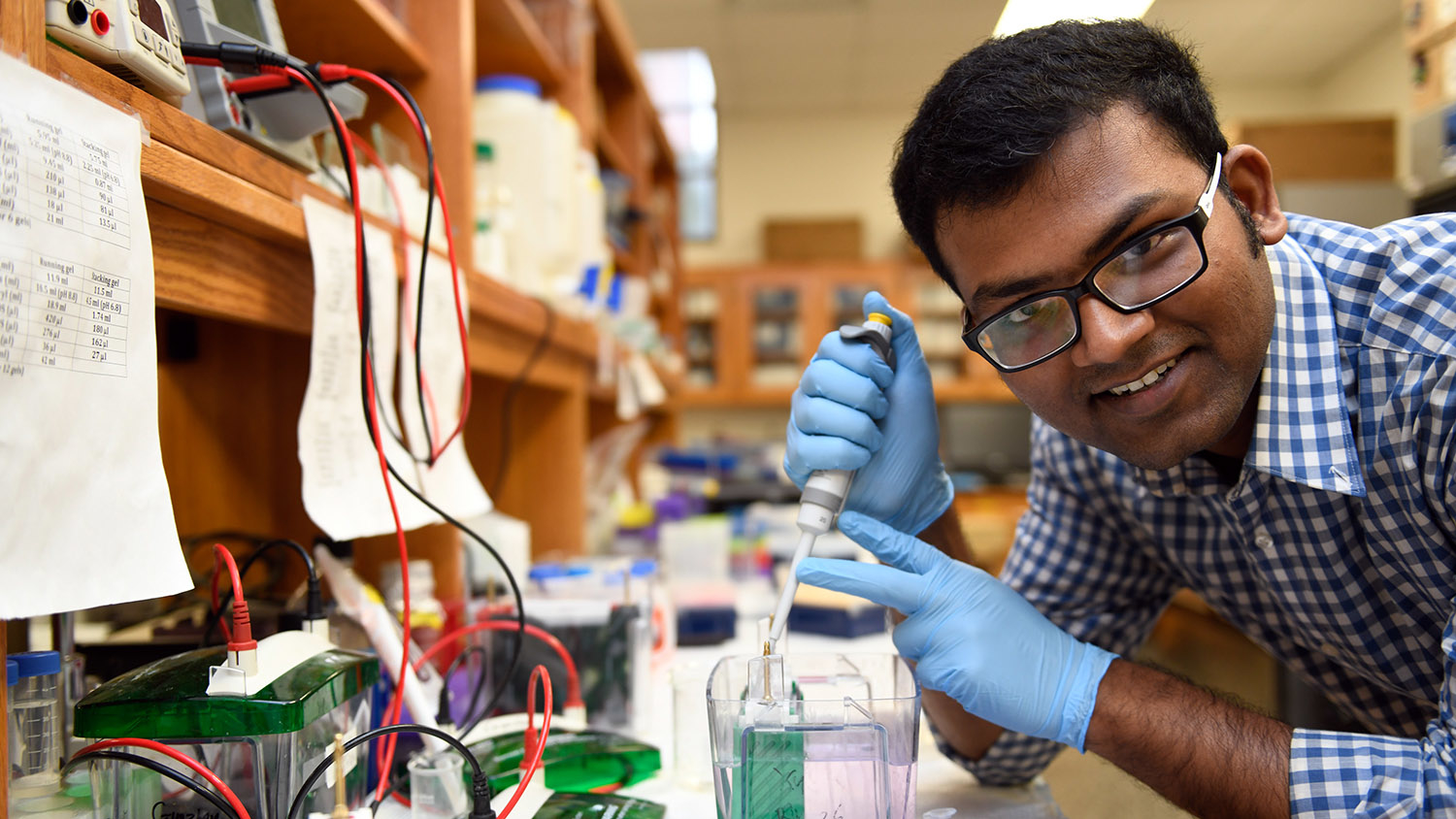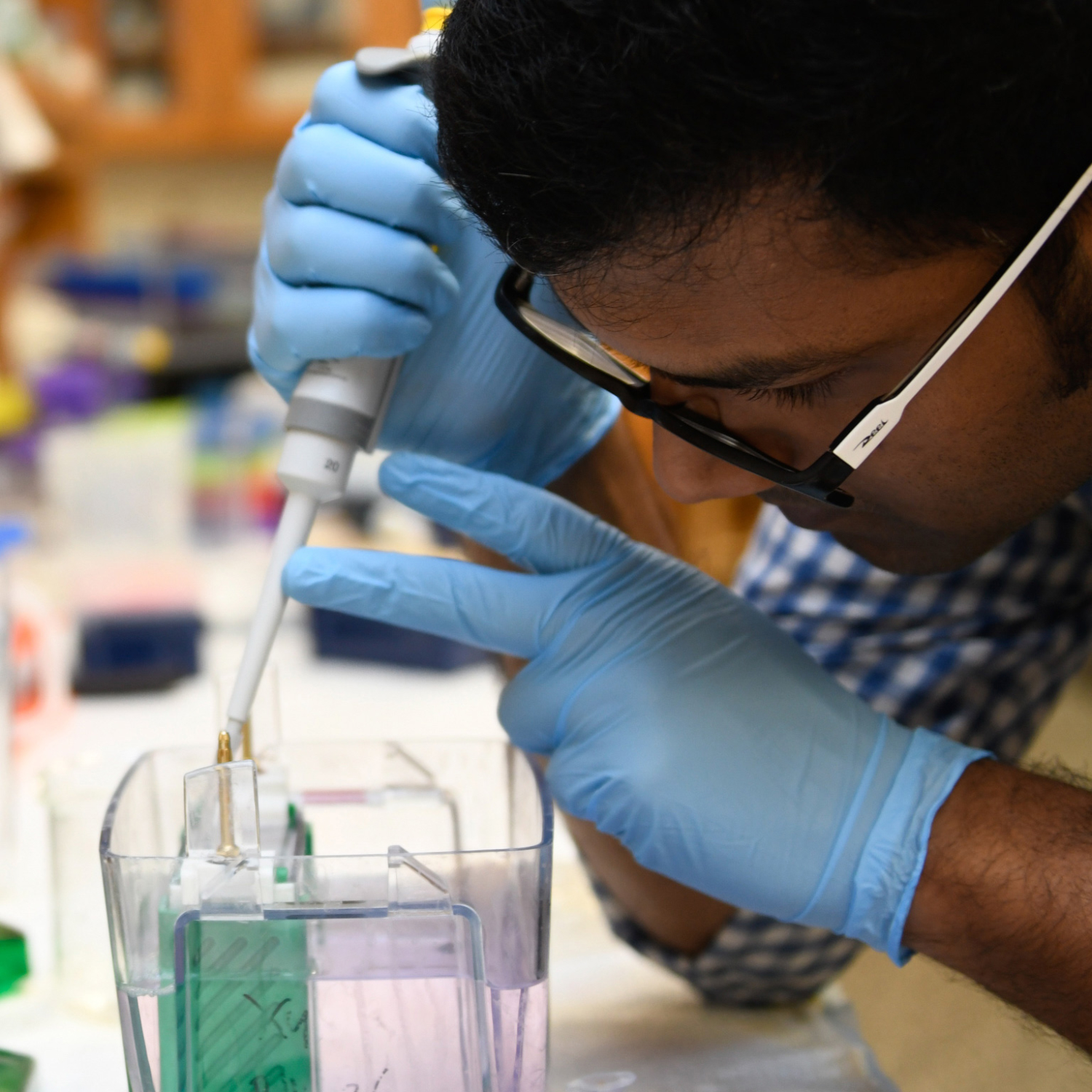Just The Facts
Inside our bodies, we have cellular signaling networks – coordinated by proteins – responsible for our proper development, defense against pathogens and more. Signaling processes regulate the activities of multiple immune-related proteins.
Sayan Chakraborty is deciphering the structures of proteins that regulate innate immune response.
Sometimes, the up-regulation, down-regulation, over-expression or inhibition of certain proteins due to something wrong in the signaling mechanism can cause fatal ailments, ranging from diabetes to neurological disorders, from autoimmune disease to cancer. Chakraborty’s work could help make medicine that targets those signaling proteins when your cellular immune system can’t.
Working in an HIV research institute as an undergraduate in India convinced Sayan Chakraborty that he should become a biochemist.
Biochemistry, with its ability to allow us to travel into the most microscopic regions of human understanding to fix some of the biggest health issues threatening humanity, would allow him to pitch in on the search for ever-better medicines to ease human suffering.
Now, Chakraborty is in his fifth and final year of his Ph.D. in the Department of Molecular and Structural Biochemistry at CALS. His research into protein structures has the potential to help develop drugs to target the altered signaling pathways that can cause lethal diseases and harm human health.
“I hope I can do something for people through my work,” Chakraborty said, “because I have seen the suffering of those patients.”
Why did you choose to study biochemistry?
During my first high school biology class the first class in India, that showed us the structure of DNA, its double helixes and how that pioneering structure has changed the field of life science. I was really excited. Because they all have functions, right? And if you have an idea how the structure looks, you can figure out the function.
And then during my undergrad in India, I worked in a research institute with HIV patients. Right now, there are a lot of good treatments and the multi-combinational drug therapy have improved a lot – with the right drugs, they can live longer than it was before.
During my undergraduate, that was not the case. People were not aware of the disease, the medicines were not highly effective. I have seen the suffering of those patients, and you feel so sad about it. That was a really important experience that made me come to the research field.
Tell us about your research.
When a pathogen enters your body, your body has its own defense mechanism that will say, “This is a foreign substance, and it is not good.” They have a mechanism to control and kill it.
But now, certain viruses have developed another strategy to overcome that innate immune response.
So we are working on a virus protein called C-6 that can block the body’s defense mechanism by binding with a separate protein. It blocks the activation of another kinase called TBK1, which is very important for the interferon signaling – the proteins which are the first level of your defense. So this virus, with C-6 proteins, blocks that mechanism so the body does not know there is something foreign and bad inside you. That means the virus can easily survive inside the body and replicate and make you sick.
Learning about the viral protein mediated signaling system will enhance our overall understanding of the immune system. This information is useful to design novel drugs to treat viral infection.
Moreover, TBK1, along with TANK, NAP1 and SINTBAD, are very important proteins associated with different kinds of diseases. If these proteins are over-expressed or up-regulated, they can cause autoimmune diseases, cancer and diabetes. Our idea is to understand the structural complexities associated with these proteins, know about how these proteins engage with the small viral protein. This structural knowledge will facilitate to design drugs which can be useful to target those proteins, to control if not completely solve our problems like cancer or autoimmune diseases.
Why is METRIC important, having access to that kind of equipment?
Cancer. Diabetes. Obesity. Our faculty and students in the Department of Molecular and Structural Biochemistry examine life’s tiniest building blocks to find solutions to the world’s most pressing health problems.Biochemistry at CALS
The synchrotron and the mass spec facility, we have used so many times to identify protein sequences or post-transmission modifications. They have an NMR facility also, another tool for solving structures and identifying protein interactions. When I came here in 2014, it was not as organized as it is now. It’s much easier now to set up a timeframe where you can do your experiment.
Why would you tell an undergraduate that they should study biochemistry?
Biochemistry is absolutely essential to know what is going on inside our cells. From DNA, RNA, proteins, signaling networks and metabolic pathways to nutrition, biochemistry is everywhere. Biochemistry is the building block of what you want to do in the future. It’s the really basic science that connects the advanced sciences – immunology, neurobiology, cancer biology, because it’s all dealing with the chemistry that is happening inside the cell.
This department in particular … conducts a diverse field of research. It’s not just protein chemistry or structural biology. The research in the department ranges from plant agricultural biochemistry, nutritional biochemistry, virology to cancer biology. The high-end instrumentations, interesting research fields and the overall infrastructure are the major reasons for choosing Biochemistry department. The new students can rotate between labs, so students can figure out which work they like. Students will be very happy.


